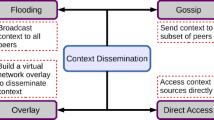Abstract
Geographical addressing and resource discovery are important services in mobile context-aware computing environments. In this paper we present a protocol that maintains a self-organizing routing backbone that supports these services. Every node taking part in the protocol actively participates in the maintenance of the network. While distributing administrative tasks, the protocol takes into account the context and capabilities of the nodes. The network acts robustly with respect to massive geographical movement of the participating nodes and runs without central administration. We also introduce the concept of context spaces that act as a tool for context-awareness, information filtering, and workload distribution. Context spaces can be used to build complex context-aware systems. Based on our protocol, we also present a new approach for structuring file-sharing networks.
Access this chapter
Tax calculation will be finalised at checkout
Purchases are for personal use only
Preview
Unable to display preview. Download preview PDF.
Similar content being viewed by others
References
Woodrow Barfield and Thomas Caudell, editors. Fundamentals of Wearable Computers and Augmented Reality. Lawrence Erlbaum Associates, 2001.
Staffan Björk, Jennica Falk, Rebecca Hansson, and Peter Ljungstrand. Pirates! using the physical world as a game board. In Interact 2001, IFIP TC.13 Conference on Human-Computer Interaction, 2001.
Antonio Carzaniga and Alexander L. Wolf. Content-based networking: A new communication infrastructure. In NSF Workshop on an Infrastructure for Mobile and Wireless Systems, Scottsdale, Arizona, October 2001.
Anind K. Dey. Providing Architectural Support for Building Context-Aware Applications. PhD thesis, Georgia Institute of Technology, 2000.
Andy Harter, Andy Hopper, Pete Steggles, Andy Ward, and Paul Webster. The anatomy of a context-aware application. In Proceedings of the Fifth Annual ACM/IEEE International Conference on Mobile Computing and Networking, MOBICOM’ 99, pages 59–68, August 1999.
Fritz Hohl, Uwe Kubach, Alexander Leonhardi, Kurt Rothermel, and Markus Schwehm. Next century challenges: Nexus-an open global infrastructure for spatial-aware applications. In Proceedings of the Fifth Annual ACM/IEEE International Conference on Mobile Computing and Networking (MobiCom’99), pages 249–255. ACM Press, 1999.
Tomasz Imielinski and Julio C. Navas. Gps-based geographic addressing, routing, and resource discovery. Communications of the ACM, 42(4):86–92, April 1999.
T. Matsuyama, L. Hao, and M. Nagao. A file organization for geographic information systems based on spatial proximity. Comput.Vision Gr.Image Process., 26(3):303–318, June 1984.
Charles Perkins, editor. Ad Hoc Networking. Addison Wesley, 2001.
Hanan Samet. The quadtree and related hierachical data structures. Computing Surveys, 16(2):1987–260, June 1984.
A. Prasad Sistla, Ouri Wolfson, Sam Chamberlain, and Son Dao. Modeling and querying moving objects. In Alex Gray and Per-A°ke Larson, editors, Proceedings of the Thirteenth International Conference on Data Engineering, April 7-11, 1997 Birmingham U.K, pages 422–432. IEEE Computer Society, 1997.
Mike Spreitzer and Marvin Theimer. Providing location information in a ubiquitous computing environment. In Proceedings of the fourteenth ACM symposium on Operating systems principles, pages 270–283. ACM Press, 1993.
Jamel Tayeb, Özgür Ulusoy, and Ouri Wolfson. A quadtree-based dynamic attribute indexing method. The Computer Journal, 41(3):185–200, 1998.
Author information
Authors and Affiliations
Editor information
Editors and Affiliations
Rights and permissions
Copyright information
© 2002 Springer-Verlag Berlin Heidelberg
About this paper
Cite this paper
Heutelbeck, D. (2002). Context Spaces - Self-Structuring Distributed Networks for Contextual Messaging and Resource Discovery. In: Meersman, R., Tari, Z. (eds) On the Move to Meaningful Internet Systems 2002: CoopIS, DOA, and ODBASE. OTM 2002. Lecture Notes in Computer Science, vol 2519. Springer, Berlin, Heidelberg. https://doi.org/10.1007/3-540-36124-3_15
Download citation
DOI: https://doi.org/10.1007/3-540-36124-3_15
Published:
Publisher Name: Springer, Berlin, Heidelberg
Print ISBN: 978-3-540-00106-5
Online ISBN: 978-3-540-36124-4
eBook Packages: Springer Book Archive




